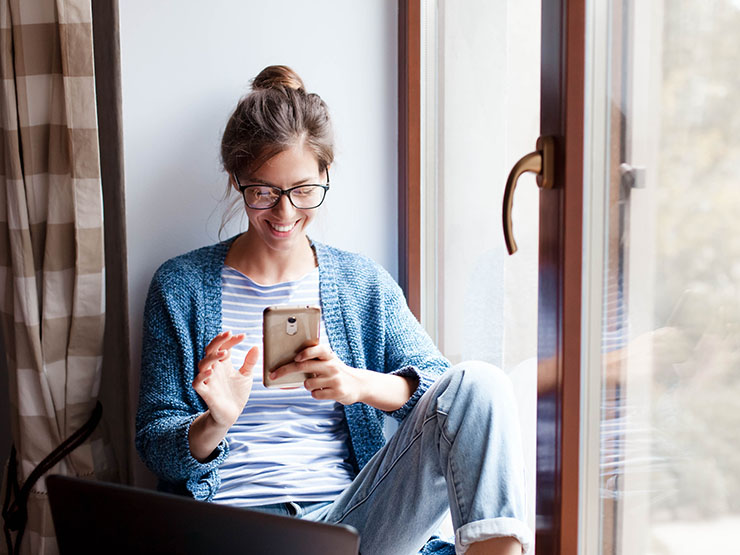WORDS JANE ZATYLNY
Two months ago, I was in the middle of a self-imposed digital detox. Too much time spent on social media was starting to affect my sleep and overall sense of well-being. I decided to reduce my screen time and spend more in-person time with family and friends. But in early March, the global pandemic known as COVID-19 radically changed our work, family and social lives. Events were cancelled, restaurants and bars were shuttered and we were told to stay at home and practice social distancing.
Now I find myself turning back to social media to hear the latest health news and to connect with family and friends. There, on Twitter, Facebook, Instagram and YouTube, I’ve been buoyed up by universal expressions of comfort, hope and solidarity. Isolated Italians singing from their balconies. Musicians offering free concerts. Late-night talk show hosts broadcasting from their backyards. Friends setting up virtual happy hours. Social media is being used as a megaphone for spontaneous expressions of our humanity.
“Social media has really evolved over the last few days,” says Tami Tate, the Victoria-based owner of Social Media Camp. “People are turning to it as a communications tool. They’re also trying to help one another cope with stress and provide entertainment.”
When social media celebrates and supports the human spirit, it rises to its original promise of positive social connection. But for our emotional health, it’s important to balance screen time with other activities. Otherwise, given the daily updates from our provincial and federal governments, the 24-hour news cycle and all the chatter and speculation in between, our minds can easily race to worst-case scenarios.
“If you are feeling fear, it’s not that you’re weak, it’s that your survival mechanism is doing its job,” explains Liz Stone, life coach and owner of Liz Stone Coaching in Victoria. “Fear is a natural response; however, it doesn’t have to run the show. This global threat is an opportunity for us to learn to live from a more open-hearted, compassionate, connected space with each other and really care for our natural world. It is also an opportunity to rethink our lives.”
Here are some strategies to help you care for yourself, those you love and your community.
Put your oxygen mask on first
Now is the time to care for your mental and emotional well-being by giving yourself more self-care than usual, Liz says: “It’s a time for more time and spaciousness, more grace, more meditation, more sleep, more fun time and relaxation, more nature time, breathing room, more love and more connection with people who matter.”
Practicing self-care in normal times is a difficult enough task for most of us. But especially in uncertain times, we really need to tend to it, she stresses. “Taking care of yourself will help calm your survival mechanism and your nervous system, so that you can bring yourself to balance and clarity,” she says. “You’ll be able to respond from a more powerful place, rather than react from fear.”
Take a class, find a new hobby or rediscover an old one
Given the hours you’re saving from commuting to work, now might be the right time to stop binge-watching Netflix and take some online language lessons, brush up on your photography skills, start the novel you’ve been wanting to write or learn how to bake. (It all sounds better than cleaning or decluttering, though you could do those things, too.) Your local library may be closed, but you can still use your card to watch thousands of free video tutorials courses from Lynda.com, an online learning platform. You can also go down the YouTube rabbit hole to learn about a topic of your choosing or, budget permitting, sign up for Masterclass, an online educational platform ($20/month), and learn from more than 80 instructors, including Gordon Ramsay, Margaret Atwood, Steve Martin, Dr. Jane Goodall and Annie Leibovitz.

Care for your community
Caring for your community can take many forms. You can help local businesses by purchasing gift cards for future restaurant visits, ordering books online and prepaying for hair appointments and other services. If you can, continue paying for services like housecleaning, dog walking, gardening or house-sitting, even though you’re not using them now. Consider joining a “Caremonger” Facebook group in your area and help a vulnerable member of your community with some of their chores.
Practice gratitude
Write down one to three things each day that you are grateful for, Liz suggests.
“Practicing gratitude allows our hearts to be connected to our heads, literally, by accessing a different part of the brain. Fear creates chemicals that close us off, whereas gratitude creates chemicals that connect us. From gratitude, we can see new ways to contribute, new vistas and new opportunities,” she says. “This is why gratitude is such a powerful practice — especially during times of threat and fear. From there, we can see the potential of a new way of living.”
Use a paper journal, Post-It notes spread around the house or an online journaling app like Day One (basic app is free), which allows users to record and store memories, photos and everyday details and annotates each entry with automatic date, location and weather information.
Find new ways to connect
Work integration and social connection of course present many challenges during self-isolation. “Here technology is playing a huge role,” says Tami, who plans to present Social Media Camp as a digital conference this year due to COVID-19 (May 5-7). Try Zoom for workplace teleconferencing or Slack for quick encrypted messages, file sharing and chatting, she suggests. “We’re going to be seeing a lot more Facebook Groups as well,” Tate predicts. “They’re really easy to set up, and you can make them private, closed groups. You can talk live there as well.” FaceTime is another great way to connect. A word of caution: read privacy policies carefully before signing up for new apps.
Go old school
Remember Bell’s old slogan, “Reach out, reach out and touch someone”? If you do, chances are you still use a phone from time to time. It remains one of the best ways to connect, so make it a habit to go through your address book (remember those?) and call friends and family, near and far away.
“A real conversation with one person can have a lasting effect because we have an innate need to be understood and ‘gotten,’” says Liz. Tami agrees: “Even though social media informs and entertains, we still need face-to-face human contact, whether that’s by phone or FaceTime.”
Finally, be present
This global crisis provides us with an opportunity to practice being very present every day, says Liz. “We normally live with our minds in the past or the future, not the present. As Eckhart Tolle has taught, in the present moment, all is well. You are here, alive. We often fear the future, we don’t fear the present moment; so go there.”


 Sacred Supper – How you eat is as important as what you eat
Sacred Supper – How you eat is as important as what you eat